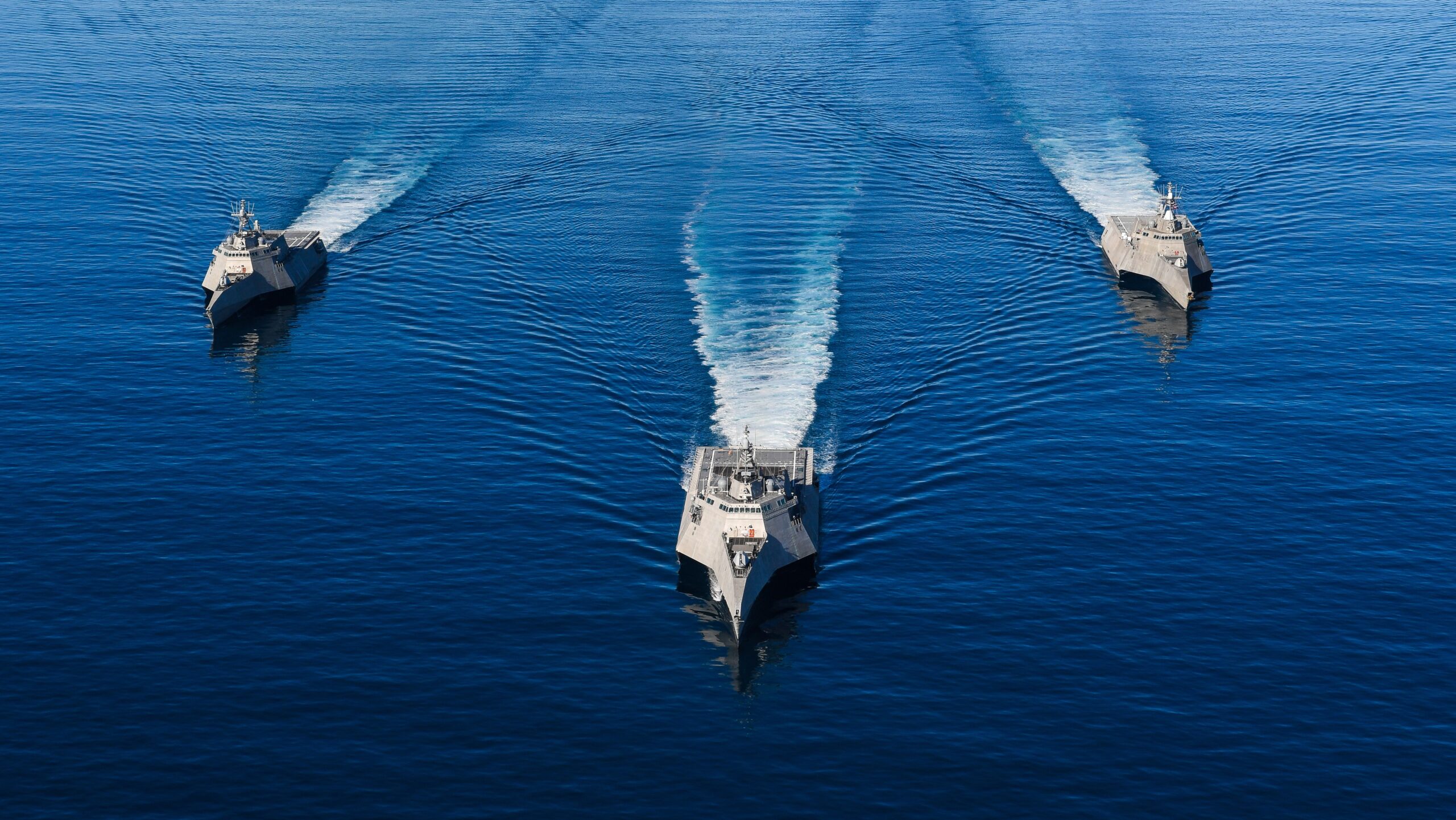
Three Independence variant littoral combat ships sail in formation in the eastern Pacific. (U.S. Navy photo by Chief Mass Communication Specialist Shannon Renfroe/Released)
SNA 2023 — The US Navy’s surface force has a new objective that its top operational officer says will drive “every program and action” across the fleet’s enterprise: maintaining 75 mission-capable ships on any given day.
“This is driven by looking at … operational requirements, looking at exercise requirements, looking at fleet requirements. [It’s] about what we need to have in order to fulfill our requirements,” Vice Adm. Roy Kitchener told reporters last week ahead of the annual Surface Navy Association symposium.
Kitchener is the commander of naval surface forces, also referred to as the “SWO Boss” because he is effectively the most senior operational surface warfare officer in the Navy. He declined to explain further how his team calculated the number, citing classification issues, but did say that the new “north star” objective is the first of its type for the surface warfare community.
FULL COVERAGE: Surface Navy Association’s 2023 symposium
To get there, Kitchener is breaking ships down into three categories: non-mission capable, fully-mission capable and mission capable. The first category, non-mission capable, represents vessels undergoing maintenance that would prevent it from being deployed in any useful operational capacity.
The ideal rating, fully-mission capable, are vessels that have completed all their relevant training certifications, are not in maintenance and are deployed or ready to embark. In other words, a warship fully ready to execute missions.
RELATED: Navy’s SWO Boss standing up readiness cells to prepare ships for deployment
The final rating, mission capable, the category off which Kitchener’s new objective is based, defines a ship somewhere between the previous two labels. It’s a vessel capable of deploying and executing missions but may have a limitation or issue that is holding it back from a totally clean bill of health. For example, when the Navy discovered a class-wide problem in the Freedom variant of the Littoral Combat Ship, service brass ordered those vessels to limit their speed to avoid triggering the underlying problem with the combining gear.
Kitchener declined to answer questions about the current state of readiness in the surface force relative to his new goal, saying the exact statuses of individual vessels are classified. But he aims to reach his 75-ship goal over the next two years.
“But just to be clear, we didn’t have a number before,” he said. “We didn’t have one in the surface community. And so, this is my attempt to say ‘No, this is what it is.’”
When asked to clarify which ships are included in the 75-ship metric, a spokesman for Kitchener told Breaking Defense the data set includes a total of 164 surface ships of varying classes, including vessels undergoing maintenance. The figure excludes carriers, submarines, Military Sealift Command vessels and ship classes that contain very low numbers of operational ships such as the Zumwalt-class destroyers and the expeditionary sea bases.
“It’s also important to point out that North Star 75 is not just about achieving a number, it’s about total force improvement in all measures of performance across all areas of readiness that contribute to mission capability,” said Cmdr. Arlo Abrahamson, Kitchener’s spokesman.
A Number For Lawmakers To Watch
Steven Wills, an analyst at the Center for Maritime Strategy, told Breaking Defense the readiness statistic Kitchener proposed “sounds like another plan… to get around the fact that there are not enough ships in the Navy to support deployed forces” in the three forward hubs: the Western Pacific, the Persian Gulf and the Mediterranean/European theater.
“The US Navy lacks the operational level of war maritime strategy that it had in the 1980s that would have provided additional specifics on how many ‘ready’ ships are needed in each area of operations,” he said. “How does the 75 number relate to the overall size of the fleet? [Combatant commander] demands have in the past exceeded the number of ready ships the Navy could provide.”
Wills said the metric “seems less ambitious than what was attempted in the [Optimized Fleet Response Plan], but once you set a number someone will be watching to see if you drop below.”
The Optimized Fleet Response Plan, or O-FRP, was a construct the Navy developed in recent years to efficiently train and deploy sailors on quick enough timelines to meet the service’s global obligations. But, it came under scrutiny in 2020 by Chief of Naval Operations Adm. Michael Gilday who acknowledged the concept required a second look.
Wills added that the 75-ship metric should be examined by the Congressional Commission on the Future of the Navy, a new independent panel established by the previous Congress tasked with scrutinizing a wide array of Navy readiness issues.
The readiness of the Navy’s surface force has become a hot button issue since the summer of 2017 when two warships, the Fitzgerald (DDG-62) and John S. McCain (DDG-56), were involved in separate collisions that ultimately killed 17 Navy crewmembers — seven from the Fitzgerald and ten from the McCain.
Since then, the Navy also lost the Bonhomme Richard (LHD-6) in a massive July 2020 fire. The seaman accused of intentionally starting the fire was ultimately found not guilty by a Navy judge last year.
The investigations into those individual incidents found several general issues, ranging from overworked and excessively tired crew to unclear chains of command to failures in following standard operational procedures. The result has been the US Navy consistently finding itself under Capitol Hill’s spotlight and being pressed to explain who among the top brass will be held accountable and how another tragedy will be avoided.
Now, lawmakers will have another metric by which to judge the naval force. As for Kitchener’s new 75-ship goal, the three-star admiral was confident that it will be more than just another number.
“We’re going to make it work,” he said.






















